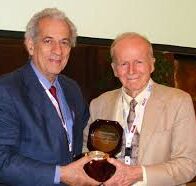John D.C. Little
Title of Presentation: Applications of Little’s Law
26th European Conference on Operational Research
Rome, Italy
July 2013
Abstract:
Queues are everywhere. We shall show pictures of them. Some queues contain people, others contain things, and still others elephants. Generically, we call them all items. Some pictures of queues are particularly interesting, or display obvious difficulties, or are funny. Little’s Law (LL) is a property of queues. LL’s simple equation contains three parameters. Expressed in words: (the average number of items in the queuing system (usually denoted, L) = the arrival rate of items to the system (denoted by the Greek letter, lambda) x (the average time an item spends in the system (denoted W ). Thus, L = (lambda) W, is Little’s Law.
You can tell that Little’s Law is useful and possibly important. Otherwise it would have no name at all. I did not name it myself. On the other hand, I haven’t objected to it.
After showing pictures of various styles of queues, we shall prove Little’s Law in a simple but important case. Not only do we prove it, we give a physical intuition as to why it is true. Notice also that it is exactly true. That’s the law.
LL has many applications, mostly unreported. This spring I ran a course with the title of this talk “Applications of Little’s Law.” I sought out several guests who had applied it themselves. My colleague, Richard Larson, told how he used LL to analyze the MIT appointment process with its input of assistant professors and output of faculty retirements. He sought and found policy implications. John Carrier, a consultant in the Boston area, analyzed a medium sized furniture maker in Kentucky who was in financial trouble. He amazed me by finding the LL parameters from the financial statements of the company. He used these values to argue for cutting down the number of line items, thereby saving setup costs, shortening product lead times, and overcoming the cost advantages of foreign competitors by providing faster service. Profits increased. Mike George, a long time entrepreneur and advocate of building a manufacturing operation centered on LL, had sold his consulting firm, which did this, to Accenture for over $100 million. He has now bought two manufacturing companies to run himself. He has already made them more profitable and we shall explain how. His firms specialize in the precision machining of jet engine parts. This a growing market because new materials permit more efficient engines, which will be snapped up by the airlines.
Finally, I shall try to make generalizations about what makes Little’s Law useful so that it can work for you.
Bio
John D. C. Little is an Institute Professor at MIT and Professor of Management Science in the MIT Sloan School. He has had a distinguished career spanning five decades. He has published seminal papers in operations research methodology, traffic signal control, decision support systems, and especially marketing. In operations research he is best known for his proof of the queuing formula, L = (lambda) W, commonly known as Little’s Law.
Considered a pioneer in marketing science, Little has done research on a broad set of modeling and decision support issues, including models of individual choice behavior, adaptive control of promotional spending, and marketing mix models for consumer packaged goods. He is co-editor with Blattberg and Glazer of The Marketing Information Revolution, HBS Press (1994).
When the Internet burst on the scene, Little was quickly attracted to e-commerce and co-taught the first course on the subject at MIT Sloan. In addition to his continuing interest in consumer packaged goods and digital business, he has been co-developing an application of Little’s Law in finance.
Among Little’s honors, he has been elected to the U.S. National Academy of Engineering and has received the Parlin and Converse Awards of the American Marketing Association. He has several honorary degrees. He has long been active in professional societies. He was president of ORSA and later TIMS and chaired the committee that led to their merger into the Institute for Operations Research and the Management Sciences (INFORMS). Little was its first president. He is a Fellow of a number of societies including INFORMS, the American Association for the Advancement of Science, and the INFORMS Society for Marketing Science.

